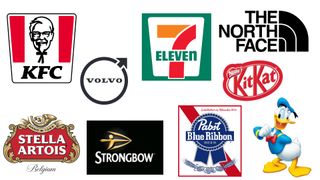For one reason or another, some brands are perceived differently in different countries. Perhaps a company is wildly popular in one country as a premium brand, but is seen as unremarkable in another, for example. This might be down to cultural quirks, clever advertising, or how the brand fits into the market.
Of course, there are some huge iconic brands, like McDonald’s and Coca-Cola, where marketing and brand perception don’t really differ to a huge extent, but this isn’t the case for most brands.
Here, I take a look at some of the biggest and most interesting differences in brand perception by country. My list doesn't include the best logos in the world, and these brands (like many) aren't necessarily following the latest logo design trends, but there are some big names here.
01. KFC

KFC has been popular in the US for decades, and soon branched out across the world starting with countries like Canada, the UK, the Philippines and Mexico. In a lot of markets, particularly in the West, KFC is seen as a convenient, reliable fast-food option – but maybe not something you’d choose for a special occasion.
However, KFC is huge in Japan. The country is its third-largest market after the US and China, and residents often order KFC for parties and social events. Most notably, across the last five decades, KFC has become a Christmas tradition for many Japanese people. This was down to ‘KFC for Christmas’ advertising campaigns, showing just how emphatic a successful campaign can be – Christmas Eve accounts for around 5% of KFC’s annual revenue in the country.
02. Strongbow

In the UK, Strongbow is often seen as a cheaper cider brand aimed at young pint-drinking adults, and in its early days, it was marketed as a cider for men – an alternative to beer.
A few years ago, a few social media users and news outlets poked fun at the differences in marketing and brand perception between the UK and the US where Strongbow is concerned. In the US, Strongbow is marketed as a drink to enjoy with friends, often in smaller glasses and with ice. And, there are more women present in its US ads.
Get the Creative Bloq Newsletter
Daily design news, reviews, how-tos and more, as picked by the editors.
Dying at the differences between Strongbow’s UK & US marketing pic.twitter.com/u0Bhyh1sFCMay 11, 2018
03. Volvo

The Swedish vehicle manufacturer Volvo is often thought of as being a reliable, safe, high-quality brand. According to a 2013 study, Swedish and American respondents used words like ‘safe’, ‘reliable’, ‘durable’, and ‘practical’ to describe Volvo, with many also associating the brand with family.
Chinese respondents shared similar thoughts. However, they also described Volvo as being expensive and upscale, and said that Volvo’s vehicles are usually driven by men. As a result, the connotations Volvo has differed between male and female respondents – Chinese women described the idea of driving a Volvo as exciting, perhaps due to the brand being associated with men in the country.
04. Pabst Blue Ribbon

Pabst Blue Ribbon has been a popular beer choice in the US for years, if not a particularly highbrow one. It’s often associated with hipsters, Midwesterners, and blue-collar workers, with country artists like Johnny Russell and Zac Brown mentioning it in their lyrics.
But while it’s considered an inexpensive, non-fancy option in its native US, it’s an expensive, premium brand in China. Known as Blue Ribbon 1844, it was reported in 2010 that a bottle cost the equivalent of around $44. It wasn’t the same brew, with PBR 1844 being a special brew that was only sold in China. So now you know.
05. Kit Kat

The chocolate-covered wafer bar Kit Kat was first made in the UK in 1935, and is produced by Nestlé around the world apart from in the US, where it’s made by Hershey. In its marketing, the idea of having a ‘break’ is often used, so much so that one UK billboard simply said 'have a', without the end of the sentence.
While the Kit Kat is popular worldwide, both the traditional bar and the various flavours and formats launched, the chocolate bar has connotations of good luck in Japan as its name sounds similar to the phrase 'Kitto Katsu', which means 'surely win' in Japanese. They’re often popular gifts around exam season in particular. Since 2000, Nestlé has launched over 300 different Kit Kat flavours in the country, from strawberry and banana to soy sauce and cough drop, in large part to appeal to a younger market.
06. 7-Eleven

7-Eleven has been going for almost a century, and took on its current name in 1946 to reflect its opening hours. Its convenience stores are of course ubiquitous in the US, and well-known for their Slurpees and Big Gulp drinks. However, 7-Eleven is found in many more countries, including Japan.
Japan has more 7-Eleven stores than anywhere else worldwide, with almost one-third of all stores located there. It’s extremely popular in Japan, and the stores are a little different, selling a broader range of products and offering more services than they do elsewhere. It’s loved due to the quality and price of the food, and also the convenient opening hours – Japan often has long working hours so 7-Eleven is a popular choice.
07. Stella Artois

One of the most popular beers in the UK, the Belgian beer Stella Artois has been around for centuries. And in the UK, it went from being advertised as a ‘strong’ lager for men to being marketed as ‘Reassuringly Expensive’ – a premium lager. However, in recent years it has attracted negative connotations, even being nicknamed 'wife beater' for perceived links between men drinking Stella and domestic abuse.
Not so all over the world. In the US, it’s still seen as a premium beer, and much of its revenue in the country came from restaurant dining. As a result, it was affected more than many by the pandemic, and has aimed to target the casual dining market, and people having dinner at home with friends.
08. Donald Duck

Disney’s Donald Duck, a friend of Mickey Mouse and Goofy, has been a popular character across the world since he made his debut in 1934. But while he’s overshadowed in most markets by Mickey, the company’s icon, his popularity is huge in the Nordic countries.
Across Norway, Sweden, Denmark, Finland and Iceland, one of the biggest Christmas Eve traditions is to watch the 1958 Disney Christmas special From All of Us to All of You, and in Sweden it’s often simply referred to as Kalle Anka, or Donald Duck. He’s such a big name, he’s sometimes seen as more popular than Mickey himself.
09. The North Face
The North Face is sometimes seen as preppy in the US, and as the sort of brand well-liked by affluent college students as well as active people.
In the UK, it used to be seen as a brand worn by outdoorsy people – middle-aged couples who go on countryside hikes – not a million miles away from how it’s seen across the Atlantic. However, it’s since tried to market itself as a streetwear label. It’s become popular in recent years as a premium brand for cool, streetwise young people in cities, and has been adopted by the ‘roadman’ subculture.
Want more on branding? Why not look at how branding has developed over time with the history of logos, or take a look at the best logos of the 2010s?






